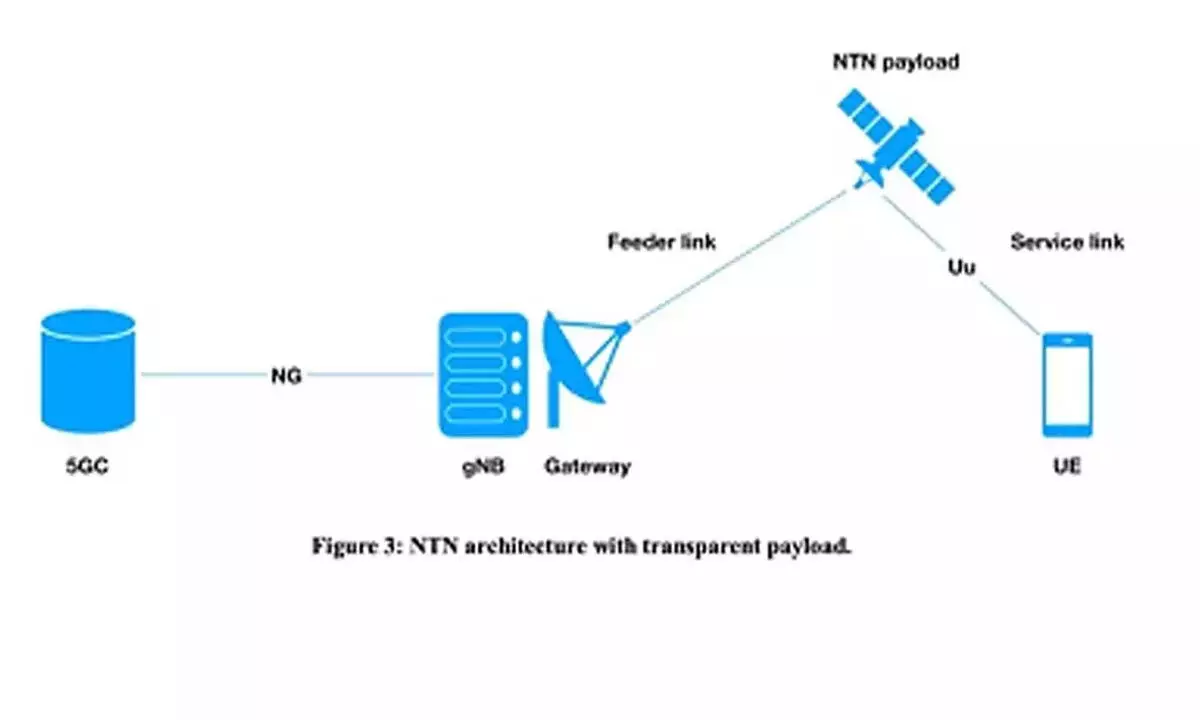Integration of terrestrial-NTN system key to 5G service continuity

Integration of terrestrial-NTN system key to 5G service continuity
An integrated terrestrial-NTN system may offer benefits in urban and rural areas. It gives connectivity guarantee at stadiums, shopping malls and for users travelling in high speed trains, in air planes and ships
It is predicted that by the end of 2024, smartphones will consume more than 21 GB data per month per phone and generate 95 per cent of total mobile data traffic. In this context, providing desired quality of service anytime anywhere, even when travelling in high speed trains, aeroplanes and ships is a challenge for future telecom systems.
5G telecom systems are expected to deliver services anywhere and anytime. 5G integrated with Non Terrestrial Network (NTN) Systems, especially satellite systems, are able to satisfy this requirement and offer wide area coverage, availability, continuity and scalability. These systems are called 5G-NTN. 5G-NTN also ensures service continuity of machine to machine and IOT (Internet of Things) devices and service availability for critical communications.
Different NTN platforms
The NTN platforms are grouped into two main categories: Spaceborne and airborne.
Spaceborne platforms
1. Geo Earth Orbit (GEO) or Geostationary Orbit (GSO): This orbit is at an altitude of 36,000 km from the surface of earth. The satellite placed at GEO, revolves around the earth from east to west at the same speed at which earth rotates around itself (24 hrs). It appears as fixed in the sky for the earth station. So tracking the satellite by earth station antenna is easy. Hundreds of GEO satellites are in orbit today launched by different countries (with separation as low as 0.5 degree). Large coverage is one of the advantages of GEO satellites and theoretically three satellites are enough to cover the entire world. The GEO beam footprint size is 200 to 3,500 km. The signal using the GEO satellite has a latency of about 240 milliseconds. Round trip delay is about 480 milliseconds. Lifetime of a GEO satellite is 10-15 years. Its launch cost is high.
2. Medium Earth Orbit (MEO): A MEO satellite will be at an altitude of 8,000 to 18,000 km above the surface of earth. It has a circular orbit and rotation period is 2 to 8 hours. 100-150 satellites are required to cover the entire world. Its lifetime is 10-15 years and launch cost is moderate. MEO beam footprint size is 100 to 1000 km.
3. Low Earth Orbit (LEO): A LEO satellite will be at an altitude of less than 2,000 Km. It has a circular orbit and orbital period is 10 to 40 minutes. LEO beam footprint size is 100 to 1000 km. Low latency (20 ms), high capacity and low launch cost are its attractive features. However, hundreds of satellites are required to cover the world, and its tracking is complex. Another disadvantage is that its lifetime is only 5 years.
LEO satellites and MEO satellites are also known as Non-GEO (NGSO) satellites.
The airborne category consists of Unmanned Aircraft Systems (UAS) platforms which are placed at an altitude between 8 and 50 km and include High Altitude Platform Systems (HAPS) at 20 km altitude.
Spaceborne and airborne platforms can be of transparent payload configuration or regenerative payload configuration. In the first configuration, radio frequency filtering, frequency conversion (as uplink and downlink frequencies are different) and amplification are done onboard the satellite or UAS platform. In the regenerative payload configuration, the NTN platform implements gNB (5G base station) functions on board.
5G NTN use cases
5G NTN can find applications in transport, health, energy, automotive and public safety sectors. 5G use cases can be classified as
1. Service continuity: To provide services which are not feasible through terrestrial networks like in remote, hilly, rural areas and islands.
2. Service ubiquity: To improve network availability in cases of disasters that lead to temporary outage of terrestrial network.
3. Service scalability: To off load traffic from terrestrial networks during busy hours.
NTN supports
1. e MBB (enhanced Mobile Broadband): Providing Broadband connectivity in unserved/ underserved areas and on moving platforms (vessels and aircrafts) and providing network resilience by combining terrestrial and NTN systems. NTN can also be used to off load the terrestrial network by making a broadcast channel available to deliver broadcast/ multicast content or wide/local area public safety messages to hand held or vehicle mounted User Equipments (UEs) or moving platforms.
2. m MTC ( massive Machine Type Communications): NTN supports connectivity for both wide and local area IOTs.
u RLLC (ultra Reliable Low Latency Communications) is a challenge in NTN due to higher satellite propagation delay.
The key use cases of NTN are solutions for maritime scenarios. Provision of in-sea coverage is not feasible using terrestrial networks. NTN is useful for maritime scenarios by providing seamless sea telecom services to devices and users with seaborne platforms.
The integration of NTN and terrestrial networks is essential to guarantee service continuity and scalability in 5G and beyond systems. An integrated terrestrial-NTN system may offer benefits in urban and rural areas. It gives connectivity guarantee at stadiums, shopping malls and for users travelling in high speed trains, in air planes and ships.
The NTN segment, when integrated with the terrestrial network, achieves global coverage because of boosting capacity (as a result of high frequency reuse and precoding techniques) and ensures service continuity even when travelling.
GEO High Throughput Satellite (HTS) and LEO satellite mega- constellations will be the focus of attention for 5G-NTN. GEO HTSs with high data rates facilitate the provision of eMBB services and LEOs support low latency 5G services (uRLLC). The concepts of network slicing (which ensures scalability, availability and resource optimisation due to the provision of specific network capabilities with a logical network, customised based on service requirements) and edge computing (shifting computing and storage resources closer to user, leading to lower latency) which are adopted in 5G terrestrial networks (in Stand Alone mode) are also adopted in 5G satellite networks.
A typical 5G- NTN architecture is depicted below:
Here 5GC is 5G core, NG is Next Generation RAN (Radio Access Network), gNB is Next Generation Node B (which is the basestation of 5G), Uu is the interface between base station and User Equipment and UE is User Equipment
Way forward
Satellite links are being used as backhaul where laying optical fibre for backhaul is not feasible. Also there is increasing interest to integrate satellite and terrestrial network infrastructure in relation to 5G. The integration of 5G with NTN is going through a series of technological advancements and soon satellites will be a part of the 5G ecosystem. The potential role of satellites to complement terrestrial 5G services has been identified during 3GPP (3rd Generation Partnership Project) Release-15 and Release-16. Now 3GPP has finalised specifications for the integration of 5G with satellites (5G-NTN) in the 3GPP release-17 which is frozen during March 22. There are a lot of changes that need to be carried out in both the protocol and hardware stack for which research on both core and RAN of 5G along with NTN (Satellite) has to be done. Mobility management, propagation delay management and radio resource management of satellites are the main issues on which research has to be focussed.
• Mobility management
As the speed of motion of the NGSO satellite and User Equipment (UE) around the earth are different, it yields a time varying NGSO channel. The dynamic nature of the NGSO satellite link has an impact on handover and paging procedures.
• Propagation delay management
The propagation delay of satellites affects system performance and is the main challenge for uRLLC applications and for public safety applications. It has to be researched how to handle channel variations due to propagation delay and ensure service continuity.
• Radio resource management
1. The spot beam technology in HTS gives improved capacity. Efficient frequency reuse is required to avoid interference between adjacent beams.
2. The integration of NTN with the 5G terrestrial system can be used to off load terrestrial traffic. Radio resources need to be allocated efficiently to limit the interference between the satellite and gNBs.
(The author is a former Advisor, Department of Telecommunications (DoT), Government of India)




















